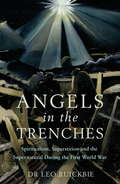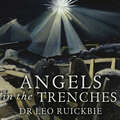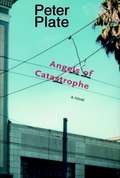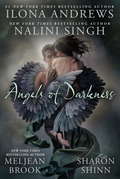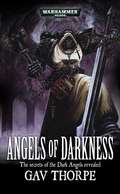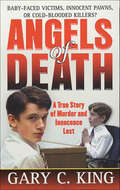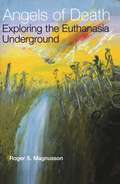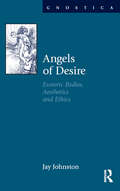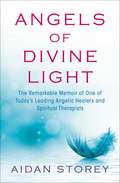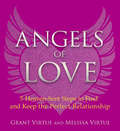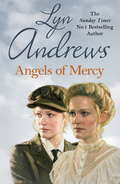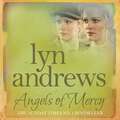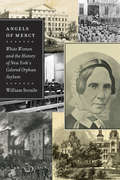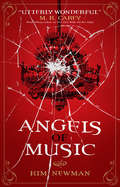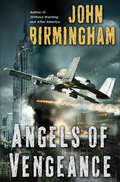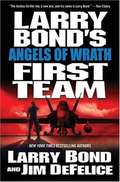- Table View
- List View
Angels in the Snow: An Anthology (Mistletoe and Maternity)
by Sarah MorganIndulge with these irresistible and heart-warming Christmas romances by USA Today bestselling author Sarah Morgan! Featuring previously published titles Christmas Eve: Doorstep Delivery and Snowbound: Miracle Marriage.Do fairy lights and family make the perfect Christmas?Daniel is dreadful at tinsel, fairy lights and families. Put in charge of his brother’s kids, Daniel panics. Surely, he can’t ask Stella for help?It used to be her favourite season, until Daniel began — and ended — their engagement on Christmas Eve. Still, Stella can’t refuse a desperate plea. The children deserve the best Christmas ever!Meanwhile, shivering on the snowy doorstep of High Fell Barn, Hayley’s regretting her impulsive response to a job avert. It’s too late, the door is opening to reveal a rather cross — but impossibly sexy — man…Patrick hadn’t advertised for a housekeeper — Alfie, his ten-year-old son, has taken matters into his own hand. Still, Hayley might be the perfect gift.Alfie and his little sister are no angels. But they know a lot about the magic of Christmas — and they’re about to teach the grown-ups a much-needed lesson!
Angels in the Trenches: Spiritualism, Superstition and the Supernatural during the First World War
by Leo RuickbieAfter a miraculous escape from the German military juggernaut in the small Belgian town of Mons in 1914, the first major battle that the British Expeditionary Force would face in the First World War, the British really believed that they were on the side of the angels. Indeed, after 1916, the number of spiritualist societies in the United Kingdom almost doubled, from 158 to 309. As Arthur Conan Doyle explained, 'The deaths occurring in almost every family in the land brought a sudden and concentrated interest in the life after death. People not only asked the question, "If a man die, shall he live again?" but they eagerly sought to know if communication was possible with the dear ones they had lost.' From the Angel of Mons to the popular boom in spiritualism as the horrors of industrialised warfare reaped their terrible harvest, the paranormal - and its use in propaganda - was one of the key aspects of the First World War.Angels in the Trenches takes us from defining moments, such as the Angel of Mons on the Front Line, to spirit communication on the Home Front, often involving the great and the good of the period, such as aristocrat Dame Edith Lyttelton, founder of the War Refugees Committee, and the physicist Sir Oliver Lodge, Principal of Birmingham University. We see here people at every level of society struggling to come to terms with the ferocity and terror of the war, and their own losses: soldiers looking for miracles on the battlefield; parents searching for lost sons in the séance room. It is a human story of people forced to look beyond the apparent certainties of the everyday - and this book follows them on that journey.
Angels in the Trenches: Spiritualism, Superstition and the Supernatural during the First World War
by Leo RuickbieAfter a miraculous escape from the German military juggernaut in the small Belgian town of Mons in 1914, the first major battle that the British Expeditionary Force would face in the First World War, the British really believed that they were on the side of the angels. Indeed, after 1916, the number of spiritualist societies in the United Kingdom almost doubled, from 158 to 309. As Arthur Conan Doyle explained, 'The deaths occurring in almost every family in the land brought a sudden and concentrated interest in the life after death. People not only asked the question, "If a man die, shall he live again?" but they eagerly sought to know if communication was possible with the dear ones they had lost.' From the Angel of Mons to the popular boom in spiritualism as the horrors of industrialised warfare reaped their terrible harvest, the paranormal - and its use in propaganda - was one of the key aspects of the First World War.Angels in the Trenches takes us from defining moments, such as the Angel of Mons on the Front Line, to spirit communication on the Home Front, often involving the great and the good of the period, such as aristocrat Dame Edith Lyttelton, founder of the War Refugees Committee, and the physicist Sir Oliver Lodge, Principal of Birmingham University. We see here people at every level of society struggling to come to terms with the ferocity and terror of the war, and their own losses: soldiers looking for miracles on the battlefield; parents searching for lost sons in the séance room. It is a human story of people forced to look beyond the apparent certainties of the everyday - and this book follows them on that journey.
Angels in the Trenches: Spiritualism, Superstition and the Supernatural during the First World War
by Leo RuickbieAfter a miraculous escape from the German military juggernaut in the small Belgian town of Mons in 1914, the first major battle that the British Expeditionary Force would face in the First World War, the British really believed that they were on the side of the angels. Indeed, after 1916, the number of spiritualist societies in the United Kingdom almost doubled, from 158 to 309. As Arthur Conan Doyle explained, 'The deaths occurring in almost every family in the land brought a sudden and concentrated interest in the life after death. People not only asked the question, "If a man die, shall he live again?" but they eagerly sought to know if communication was possible with the dear ones they had lost.' From the Angel of Mons to the popular boom in spiritualism as the horrors of industrialised warfare reaped their terrible harvest, the paranormal - and its use in propaganda - was one of the key aspects of the First World War.Angels in the Trenches takes us from defining moments, such as the Angel of Mons on the Front Line, to spirit communication on the Home Front, often involving the great and the good of the period, such as aristocrat Dame Edith Lyttelton, founder of the War Refugees Committee, and the physicist Sir Oliver Lodge, Principal of Birmingham University. We see here people at every level of society struggling to come to terms with the ferocity and terror of the war, and their own losses: soldiers looking for miracles on the battlefield; parents searching for lost sons in the séance room. It is a human story of people forced to look beyond the apparent certainties of the everyday - and this book follows them on that journey.
Angels of Abundance: Heaven's 11 Messages To Help You Manifest Support, Supply, And Every Form Of Abundance
by Doreen Virtue Grant VirtueIn their travels around the globe, Doreen Virtue and her son Grant (the best-selling authors of Angel Words) have met thousands of talented people who dream of being healers, spiritual teachers, or writers; or of opening healing centers or schools.They also long to be able to afford organic food, vitamin supplements, exercise instruction, trips to spiritual power places, and wonderful homes. However, they don't move forward because they don't understand how to attract the financial resources that are the basis for how the physical world operates. Doreen and Grant wrote this book to show you how Heaven can give you material and emotional support as you strive to attain your life purpose and manifest everything you desire. Each of the 11 chapters features a message from the Angels of Abundance-the specialty angels who ensure that your Divine mission here on Earth isn't hampered by lack. Whether you wish to have more money, time, ideas, or opportunities, the Angels of Abundance will hold your hand and help you over the hurdles that have kept you from realizing your dreams-until now!
Angels of Bataan and Corregidor: The Heroic Nurses Of World War Ii (Women Warriors Of World War Ii Ser.)
by Agnieszka BiskupSoon after the Japanese attacked Pearl Harbor on December 7, 1941, they also attacked U.S. military installations in the Philippines. For the army and navy nurses stationed there, what had been a peaceful outpost quickly turned into a raging war zone. When the U.S. and Philippine forces retreated to the Bataan Peninsula and the fortress island of Corregidor, the nurses followed them to the field hospitals to care for the wounded. Persevering through enemy assault and imprisonment, these heroic women became angels of mercy amid the war in the Pacific.
Angels of Catastrophe: A Novel
by Peter PlateA cop is gunned down and unless Ricky Durrutti, a petty criminal with a short biography and a long rap sheet, can figure out who the real shooter is, he's a dead man. From Hunt's Donuts, opposite where the killing took place, to his room in the El Capitán Hotel, from the blue grass and steel Federal Building off Golden Gate Avenue to the Ritmo Latino record store, and from the Roxie Cinema on 16th Street to the Ramshackle Victorian homes of Treat Street where Lonely Boy lives--the chase is on. Salvadoreno gangs and Mexicans, cops and Jewish gangsters, drag queens and heroin addicts, speed freaks and low rent hookers, low-lives rising rising to the challenge of making sense of a murder. Out of the twentieth century of Nelson Algren and Charles Bukowski, here is the twenty-first century world of Peter Plate.
Angels of Darkness
by Sharon Shinn Nalini Singh Ilona Andrews Meljean BrookTales of alpha angels...from four alpha authors. They soar through the night, unearthly creatures of legends and lore. Four masters of urban fantasy and paranormal romance explore the rapture of the heavens above, and the darkness below in four all-new stories of angels and guardians, and good and evil.
Angels of Darkness (Warhammer 40,000 Novels: Space Marines)
by Gav ThorpeTHE DARK ANGELS Space Marines are devout servants of the Imperium, but the mysterious nature of their Chapter has led some to question their motives. The Chapter harbours a dark and horrific secret that stretches back over ten thousand years to the time of the Horus Heresy. The long-buried truths from this dark time threaten to be unleashed when an Interrogator-Chaplain discovers that the line between good and evil is all too easily crossed. The truth about this mysterious Space Marine Chapter is revealed in this highly popular Warhammer 40,000 novel.
Angels of Death: A True Story of Murder and Innocence Lost (St. Martin's True Crime Classics)
by Gary C. KingThe accused: Thirteen-year-old Derek King and his twelve-year-old brother, Alex, Sunday school students with choirboy looks. The victim: Their own father.After midnight on November 26, 2001, someone bludgeoned Terry King to death while he slept, and set his Florida home afire. By the time the firefighters extinguished the blaze, King’s sons, Alex, twelve, and Derek, thirteen, were at the home of their forty-year-old friend, Ricky Chavis, a convicted child-molester. By the next afternoon, following confessions, both boys were charged as adults in their father’s slaying. Chavis was tried separately for the same crime—incredibly by the same attorney who would prosecute Alex and Derek, and argue two contradictory theories.When Alex divulged his sexual relationship with Chavis, the trial took a sensational turn. So did Alex and Derek, who recanted their confession and blamed Chavis to no avail. A jury convicted the boys of second-degree murder, but the judge threw the verdict out. Chavis was acquitted. But the case wasn’t over. As more disturbing revelations came to light, as criminal motives became more complex, and as the line between guilt and innocence was crossed, a stunned nation watched in disbelief to learn the ultimate fate of the . . . Angels of Death.
Angels of Death: Exploring the Euthanasia Underground
by Roger S. MagnussonPublic discussion of euthanasia and assisted suicide is growing. In Australia as elsewhere the debate is difficult, contentious and confronting, and hampered by the secrecy that necessarily surrounds illegal practice. Most people simply have no way of knowing how, and how often, medically assisted death actually occurs.Roger Magnusson presents, for the first time, detailed first-hand accounts by doctors, nurses, therapists and other health professionals who have been participants in assisted death. All have been intimately involved in caring for people with AIDS, both in Australia and in California. He places these ambivalent, self-incriminating accounts within the broader context of the right-to-die debate and the challenges of palliative care.The frankness of the health workers and the richness of their collected evidence set this book apart. From within a culture of deception they speak knowingly and movingly of the merciful release of a peaceful death, while acknowledging the reality of 'botched attempts', euthanasia without consent, precipitative euthanasia, lack of accountability and professional distance, and many other disturbing issues.Angels of Death provides a window into the 'euthanasia underground'—a secret part of medicine and nursing that few professionals will publicly acknowledge. It brings a sense of urgency and precision to public debate, and equips us all to think more independently about these crucial issues.
Angels of Desire: Esoteric Bodies, Aesthetics and Ethics (Gnostica)
by Jay JohnstonThe idea that the human body consists of 'subtle bodies' - psycho-spiritual essences - can be found in a variety of esoteric traditions. This radical form of selfhood challenges the dualisms at the heart of Western discourse : mind/body, divine/human, matter/spirit, reason/emotion, I/other. 'Angels of Desire' explores the aesthetics and ethics of subtle bodies. What emerges is an understanding of embodiment not exclusively tied to materiality. The book examines the use of subtle bodies across a range of traditions, yogic, tantric, theosophical, hermetic and sufi. 'Angels of Desire' shows the relevance of the subtle body for religion, philosophy, art history and contemporary feminist religious studies and theories of desire.
Angels of Divine Light
by Aidan StoreyProfoundly moving, wise, and ultimately redemptive, an inspiring personal memoir of hope and forgiveness, and an unforgettable testament to the healing power of Angels.Growing up in the suburbs of Dublin, Aidan Storey was the youngest of seven, a much-loved, happy child who enjoyed family life. But there was one difference between Aidan and his friends: When everyone left, Angels visited Aidan. Unafraid of the beautiful, luminous spirits that watched over him, it wasn't until much later that Aidan realized not everyone could see what he could--and not everyone shared his exceptional gift for healing. In this remarkable memoir, Aidan vividly recalls how the presence of Angels sustained him through years of great turmoil when his happy, carefree world turned into one of misery and torment. As he recalls the sexual and mental abuse he suffered at the hands of two teachers in his Christian Brothers primary school and the isolation which followed, Aidan tells how the Angels helped him find his way back to life and, through the power of divine healing, taught him how to bring light and love into his life and the lives of many others.
Angels of Light?
by Hobart E. FreemanAre modern seers authentic prophets of God? Can involvement in occult games cause spiritual bondage? How can one experience release from Satan Worship? Can I trust my feelings?
Angels of Love: 5 Heaven-sent Steps To Find And Keep The Perfect Relationship
by Grant Virtue Melissa VirtueFinding a soul mate and life partner is only half the story. Once you actually have a wonderful relationship, it’s important to take definitive steps to keep it. Grant and Melissa Virtue, a husband-and-wife team, offer a variety of tools and techniques to create and maintain a healthy relationship: meditations, writing exercises, affirmations, prayers, and more. Readers will also learn how to call on the Angels of Love, a council of angels dedicated to helping soul-mate relationships. Practical advice will help readers understand how to recognize the right relationship, release the baggage from their past, attract love into their lives, and be present in a relationship.
Angels of Mercy: A gripping saga of sisters, love and war
by Lyn AndrewsAs the Great War looms, two sisters' lives are about to change forever... In Angels of Mercy, Lyn Andrews writes a dramatic, moving saga of two sisters who set off to become nurses in the Great War, far from their loving Liverpudlian homes. Perfect for fans of Anne Baker, Nadine Dorries and Kate Thompson.Blue-eyed, blond-haired, full of smiles and sweetness, even as babies twins Kate and Evvie Greenway captured the hearts of Liverpool's Scotland Road slumlands. But now they are almost adults the two girls find that being pleasant, popular and blessed with a loving family isn't quite enough. For they've both fallen for men who will break their youthful hearts...But these sorrows are nothing compared to the tragedies that await them and so many others when the Great War breaks out. Determined to do their part, Kate and Evvie sign up for nursing training and are despatched to the Front, a terrible world far from the life-affirming energy of their homes. Can anything, hope, love or the bond that has always united the sisters, survive all that lies in store for them? What readers are saying about Angels of Mercy: '[This] book tugs at every single one of your emotions, and you won't be able to put it down''Lots of twists and turns for the people in this book. It made me laugh and it also made me cry... It really does make you think, but it's a page turner, and that's what Lyn Andrews does best!''Lyn Andrews ranks as one of the best saga writers in my book. Having just finished Angels of Mercy, I found this novel poignant, engrossing and unputdownable'
Angels of Mercy: A gripping saga of sisters, love and war
by Lyn AndrewsAs the Great War looms, two sisters' lives are about to change forever... In Angels of Mercy, Lyn Andrews writes a dramatic, moving saga of two sisters who set off to become nurses in the Great War, far from their loving Liverpudlian homes. Perfect for fans of Nadine Dorries and Kate Thompson.Blue-eyed, blond-haired, full of smiles and sweetness, even as babies twins Kate and Evvie Greenway captured the hearts of Liverpool's Scotland Road slumlands. But now they are almost adults the two girls find that being pleasant, popular and blessed with a loving family isn't quite enough. For they've both fallen for men who will break their youthful hearts...But these sorrows are nothing compared to the tragedies that await them and so many others when the Great War breaks out. Determined to do their part, Kate and Evvie sign up for nursing training and are despatched to the Front, a terrible world far from the life-affirming energy of their homes. Can anything, hope, love or the bond that has always united the sisters, survive all that lies in store for them? What readers are saying about Angels of Mercy: '[This] book tugs at every single one of your emotions, and you won't be able to put it down''Lots of twists and turns for the people in this book. It made me laugh and it also made me cry... It really does make you think, but it's a page turner, and that's what Lyn Andrews does best!''Lyn Andrews ranks as one of the best saga writers in my book. Having just finished Angels of Mercy, I found this novel poignant, engrossing and unputdownable'
Angels of Mercy: A gripping saga of sisters, love and war
by Lyn AndrewsBestselling author Lyn Andrews' unputdownable saga ANGELS OF MERCY is perfect for fans of Kate Thompson and Kitty Neale.Blue-eyed, blond-haired, full of smiles and sweetness, even as babies twins Kate and Evvie Greenway captured the hearts of Liverpool's Scotland Road slumlands. But now they are almost adults the two girls find that being pleasant, popular and blessed with a loving family isn't quite enough. For they've both fallen for men who will break their youthful hearts...But these sorrows are nothing compared to the tragedies that await them and so many others when the Great War breaks out. Determined to do their part, Kate and Evvie sign up for nursing training and are despatched to the Front, a terrible world far from the life-affirming energy of their homes. Can anything, hope, love or the bond that has always united the sisters, survive all that lies in store for them?
Angels of Mercy: Historical Cozy Mystery (Mercy Allcutt Mystery #4)
by Alice DuncanFamed Director and Producer, Milton Halsey Gosset, Shot Dead in Angels of Mercy, a Cozy Historical Mystery from Alice Duncan--1926, Los Angeles, CA--Former Boston Brahmin Mercy Allcutt is excited to be renting suites of rooms to deserving working women in her new Bunker Hill home. She considers it an act of good-heartedness, no matter how skeptical her boss, private investigator Ernie Templeton, is about her endeavor.When her housekeeper's son is arrested for the murder of a Hollywood big-wig, Mercy presses Ernie to solve the case. She's positive Calvin Buck is innocent. Ernie tells her he'll do his best but she's not entirely convinced he means it, so she does some snooping on her own.In the meantime, Mercy not only takes driving lessons from Ernie, she discovers there's more to being a landlady than meets the eye. One of her "Angels of Mercy" may not be what she appears. Only time, and Mercy and Ernie, will tell.Publisher Note: Readers who enjoy cozy mysteries in historical settings are sure to appreciate the Mercy Allcutt series set in 1920s Los Angeles, California. No vulgarity or explicit sex for those who appreciate a clean and wholesome read.Winner HOLT Medallion, Romantic Times tip pickTwo-time RT KISS Award WinnerNew Mexico/Arizona Book of the Year finalistNew Mexico/Arizona Book of the Year Award winnerRomantic Times Reviewer’s Choice Nominee"Mercy Allcutt is a delight." ~Carola DunnThe Mercy Allcutt Mystery SeriesLost Among the AngelsAngels FlightFallen AngelsThanksgiving AngelsAngels of Mercy
Angels of Mercy: White Women and the History of New York's Colored Orphan Asylum
by William SeraileWilliam Seraile uncovers the history of the colored orphan asylum, founded in New York City in 1836 as the nation’s first orphanage for African American children. It is a remarkable institution that is still in the forefront aiding children. Although no longer an orphanage, in its current incarnation as Harlem-Dowling West Side Center for Children and Family Services it maintains the principles of the women who organized it nearly 200 years ago. The agency weathered three wars, two major financial panics, a devastating fire during the 1863 Draft Riots, several epidemics, waves of racial prejudice, and severe financial difficulties to care for orphaned, neglected, and delinquent children. Eventually financial support would come from some of New York’s finest families, including the Jays, Murrays, Roosevelts, Macys, and Astors. While the white female managers and their male advisers were dedicated to uplifting these black children, the evangelical, mainly Quaker founding managers also exhibited the extreme paternalistic views endemic at the time, accepting the advice or support of the African American community only grudgingly. It was frank criticism in 1913 from W. E. B. Du Bois that highlighted the conflict between the orphanage and the community it served, and it wasn’t until 1939 that it hired the first black trustee. More than 15,000 children were raised in the orphanage, and throughout its history letters and visits have revealed that hundreds if not thousands of “old boys and girls” looked back with admiration and respect at the home that nurtured them throughout their formative years. Weaving together African American history with a unique history of New York City, this is not only a painstaking study of a previously unsung institution of black history but a unique window onto complex racial dynamics during a period when many failed to recognize equality among all citizens as a worthy purpose.
Angels of Modernism
by Suzanne HobsonAngels of Modernism explores the many and various ways that angels are represented in modernist literary cultures. Seen by the likes of D. H. Lawrence, H. D. and Virginia Woolf as belonging to a religious or Victorian past, the angel might easily have been consigned to history along with other tropes considered too old-fashioned or sentimental for modern(ist) literary tastes. This book argues that it is precisely the angel's lack of fit with self-consciously modern attitudes to art and belief that explains its continued attraction to modernist writers as well as its capacity to generate new meanings. On the one hand, the angel appears as a symbol of resistance to secularizing tendencies in aesthetics and religion. On the other, it is a motile figure appropriated and transformed by a variety of interests from sex-reform campaigners to designers of new utopias. From Walter Benjamin, through Djuna Barnes, H. D. , D. H. Lawrence, Wyndham Lewis, Wallace Stevens and Virginia Woolf, angels continue to perform cultural and critical work even as they are identified as incongruous and untimely.
Angels of Music
by Kim NewmanDeep in the shadows under the Paris Opera House resides Erik the Phantom, mysteriously enduring through the decades as the mastermind behind a strange and secret agency. A revolving door of female agents are charged by wealthy Parisians and the French Government to investigate crimes and misdemeanours they would prefer to keep out of the public eye. The toxic underbelly of Paris is exposed by Erik's tenacious women operatives as they confront horror and corruption throughout the city. But it is one dreadful murder during the 1910 Great Flood of Paris that brings Irene Adler, Kate Reed and others together for a final, deadly confrontation.
Angels of September
by Andrew M. GreeleyA love story about a love so enduring it lasts through 40 years of separation...
Angels of Vengeance
by John BirminghamWhen an inexplicable wave of energy slammed into North America, millions died. In the rest of the world, wars erupted, borders vanished, and the powerful lost their grip on power. Against this backdrop, with a conflicted U.S. president struggling to make momentous decisions in Seattle and a madman fomenting rebellion in Texas, three women are fighting their own battles--for survival, justice, and revenge.Special agent Caitlin Monroe moves stealthily through a South American jungle. Her target: a former French official now held prisoner by a ruthless despot. To free the prisoner, Caitlin will kill anyone who gets in her way. And then she will get the truth about how a master terrorist escaped a secret detention center in French Guadeloupe to strike a fatal blow in New York City.Sofia Peiraro is a teenage girl who witnessed firsthand the murder and mayhem of Texas under the rule of General Mad Jack Blackstone. Sofia might have tried to build a life with her father in the struggling remnants of Kansas City--if a vicious murder hadn't set her on another course altogether: back to Texas, even to Blackstone himself.Julianne Balwyn is a British-born aristocrat turned smuggler. Shopping in the most fashionable neighborhood of Darwin, Australia--now a fantastic neo-urban frontier--Jules has a pistol holstered in the small of her lovely back. She is playing the most dangerous game of all: waiting for the person who is hunting her to show his face--so she can kill him first.Three women in three corners of a world plunged into electrifying chaos. Nation-states struggling for their survival. Immigrants struggling for new lives. John Birmingham's astounding new novel--the conclusion to the series begun in Without Warning and After America--is an intense adventure that races from the halls of power to shattered streets to gleaming new cities, as humanity struggles to grasp its better angels--and purge its worst demons.From the Hardcover edition.
Angels of Wrath (First Team #2)
by Larry Bond Jim DefeliceLed by CIA agent par excellence Bob Ferguson, the Team pitches in to help the FBI investigate a radical group of zealots who want to create a "post-Christian" era by instigating a catastrophic showdown in Jerusalem. But Ferg and company soon discover that the cult has strange connections to the Iraqi resistance and to a Syrian arms dealer. Enlisting the help of Thera Majed, a beautiful paramilitary and an expert on Middle Eastern relations, the team breaks up to track each link. They seek to stop anything catastrophic from happening before the president arrives in Iraq for the next round of elections. Their quarries lead Team members into an immensely complicated world of fanatical terrorists, each potentially dangerous... but who among them is the next to strike? Uncertain of the most imminent threat, the Team finds that they have landed in the midst of an operation headed by Israel's famous Mossad and are ordered to cooperate with the Israelis... but are the Israelis cooperating with them? Unsure of their allies, the Team realizes that they are on the trail of two completely different attacks, whose targets are thousands of miles apart. Both operations are intended to trigger a vast religious war. With the clock ticking down, can the team extinguish the spark of Armageddon?

